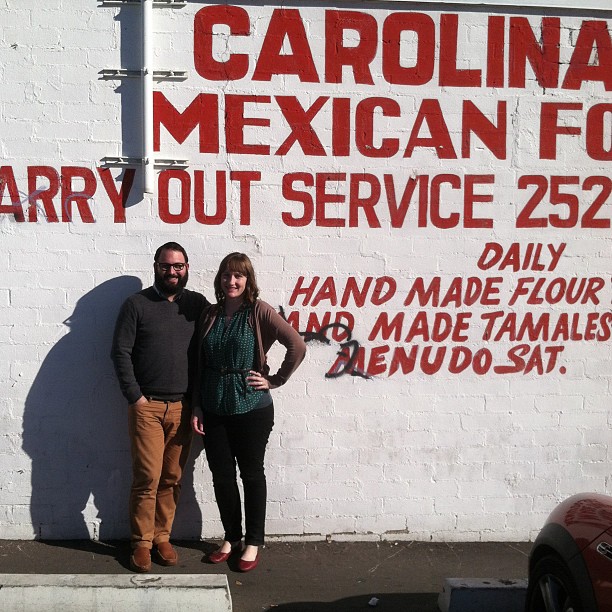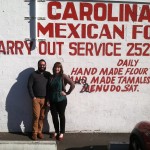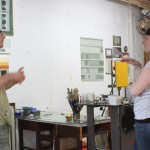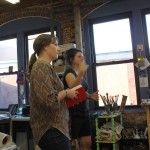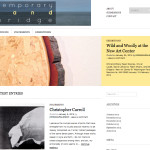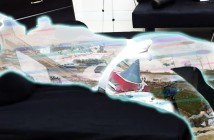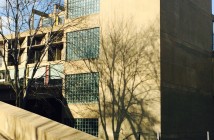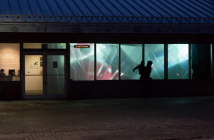Temporary Land Bridge is a website focused on art practice that I developed with my husband and fellow artist, Kirk Amaral Snow. The mission of Temporary Land Bridge is to encounter art practice at its various stages: creation, contextualization, and exhibition. We feature interviews and studio visits with artists, writing by artists, and exhibition photo essays. Our main focus is to be a platform where artists and their work can be brought to a larger audience.
I think Temporary Land Bridge exists somewhere between a blog and an online art journal; it is certainly rooted in our own subjective and personal encounters with art and artists. We are interested in providing a place for artists to speak for themselves and to make new connections.
The structure of Temporary Land Bridge is pretty simple. Kirk and I do everything ourselves, on our own time. We publish new content twice a week on Tuesdays and Thursdays, rotating between interviews, statements and exhibitions. In order to support this, we keep a pretty regular schedule doing studio visits, soliciting artist writing, and getting out to see shows.
Tell us why and how you started Temporary Land Bridge. What did you do before, and how did that work equip you for the work you do now?
I first started Temporary Land Bridge on my own in 2011. I was at a talk at the CAA conference that year, and there was a discussion about building art communities; the idea that if something is lacking, why not make it yourself? I was a few years out of grad school, and was excited about many of the things people were doing in Boston. MEME had not yet closed, and Kirk and some fellow SMFA grads had started Lufthansa, a studio and gallery in a warehouse space in Dorchester. Big Red and Shiny was on hiatus (we’re so glad to have you back!), and I was thinking a lot about what I could contribute to the Boston arts community.
I’ve always been fascinated with how different artists manage to piece their lives together, how and why they make work, and balance their everyday responsibilities. I like talking about art with other artists and I tend to be more of a listener-type, so the idea of doing interviews and studio visits felt pretty natural. It also seemed like a way in which I could support and promote the artists that I admired.
I did a few interviews with the group of SMFA grads who held their thesis show at Lufthansa; they were recorded conversations that I transcribed by hand. This was an incredibly slow process, and while I enjoyed doing the interviews, I wasn’t able to keep up. The website crawled to a halt after just a few posts, but it always stayed in the back of my mind.
Last summer, Kirk proposed that we start up Temporary Land Bridge again as a collaborative project. He brought the structure, and we talked a lot about how to make both it both active and sustainable for us to do ourselves. Some of our solutions included doing studio visits followed with interviews via email, expanding the content to include other features, and keeping a set schedule of posting new content. Kirk works as the Director of Career Services at Montserrat College of Art, so he’s pretty savvy with the whole web and social media side of things. As artists ourselves, Temporary Land Bridge has been a nice extension of our own art practices and interests.
What are your plans for Temporary Land Bridge in the coming year?
Our main goal is to just keep it going. We have an endless list of artists that we want to feature in one way or another, and we also really enjoy traveling and making connections with artists in other cities. We’re hoping that we’ll have the time and funds to do a little more of that this year.
What are some challenges you face, and how are you working to address them? What's your biggest need right now?
The biggest challenge we face is managing our time and planning ahead. Kirk has done a great job keeping me on schedule, as I tend to be an unintentional procrastinator. But at times, it’s hard to keep up, and we find ourselves scrambling to make sure we get something posted on time. Kirk works full-time, and I teach 3-4 classes a semester, we both have our own art-practices, not to mention the laundry, dishes, and the like…It’s tricky balancing it all. We’re working to get a little more ahead with our schedule. Our biggest need right now is time, but there never seems to be quite enough to go around!
What advice do you have for someone looking to follow in your footsteps? What do you wish you knew when you first started out?
I don’t know if we are quite far enough along to give too much advice yet (we have only been up and running for about four months now), but I’d say, it can be incredibly easy to do something like this. The support and positive feedback that we have received upon starting Temporary Land Bridge has been amazing. All you really need is the time and commitment to make it happen. Don’t try to do everything; narrow in on your focus. Find other people who are interested in similar things and have similar goals, with different skills to contribute, and collaborate. You don’t have to do it all yourself.
Name one challenge that the Boston cultural sector faces, and how you’d suggest fixing it.
One of the biggest challenges I see is how to make different creative endeavors sustainable. We have seen many incredible things come into being and then disappear: MEME gallery in Cambridge, Anthony Greaney, Lufthansa Studios; these are just a few of the many things that have come and gone in the past few years. We have great people here with a lot of drive to start things themselves, but it’s hard for these things to last, either due to monetary expense, the fluctuating student population of the city (so many schools, but not enough opportunities to keep people here), or simply not having enough time and energy to keep things going for the long term. I don’t know if I have a good solution on how to fix this, just the hope that people will continue to be inventive and creative, with the desire to help build the community they seek.
That said, I think the impact even these shorter-term things has on the Boston arts community is lasting, even if they don’t last themselves. They help inspire the next group of people who want to make something happen. I’ve been so pleased to see things like the Howard Arts Project continue in Dorchester, the opening of Kijidome in the South End, Big Red and Shiny revived, among many other things.
Tell us about one cultural event/exhibition or organization/individual (other than your own) that has exceeded your expectations recently. What work are they doing, and why is it important?
I’ve been really excited about what’s been happening at the New Art Center. Their Curatorial Opportunity Program has brought in some great exhibitions with new and fresh work. They have also started an Artist-in-Residence program in their Holzwasser Gallery, currently featuring Christina Pitsch, one of the artists from the "Pedigree" exhibition. It’s definitely worth the trip out to Newton!
- Kirk and Andrea of Temporary Land Bridge. Courtesy of Temporary Land Bridge.
- Studio Visit with Anthony Palocci Jr. Courtesy of Temporary Land Bridge.
- Studio Visit with Bea Modisett. Courtesy of Temporary Land Bridge.
- Temporary Land Bridge Screen Shot. Courtesy of Temporary Land Bridge.

